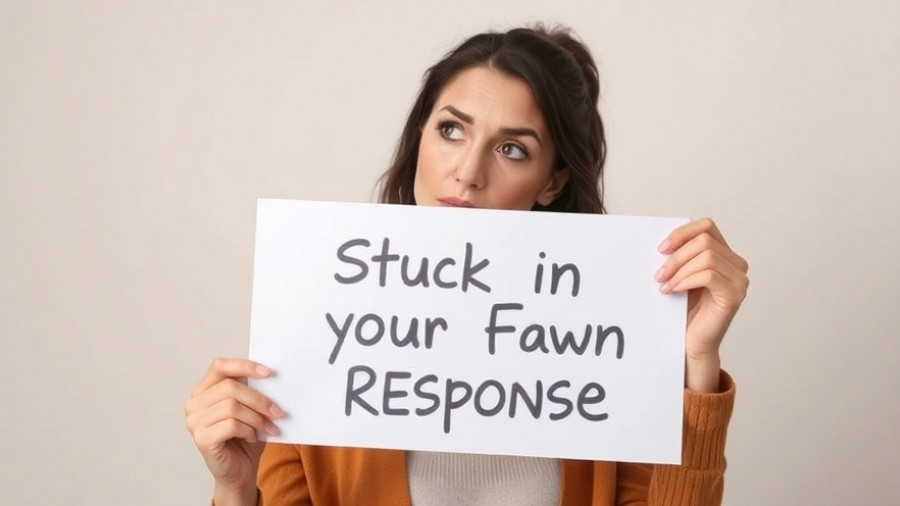
Understanding the Fawn Response: A Subtle Survival Mechanism
The fawn response is an instinctual behavior that often goes unnoticed, yet it plays a crucial role in how many individuals cope with trauma. When a threat is perceived, some may find themselves gravitating towards this survival tactic, making them more agreeable or subservient in oppressive situations. This behavior is often a learned response to past trauma, where the individual believes that pleasing others may avert danger or conflict.
In 'Stuck in the Fawn Response', the discussion dives into the nuances of this subtle yet impactful behavior, highlighting key insights that sparked deeper analysis on our end.
The Psychological Impacts of the Fawn Response
Professionals in therapy and mental health argue that the fawn response can lead to significant psychological distress. Individuals who consistently engage in this behavior may struggle with issues related to self-esteem, as their worth becomes intertwined with others' approval. This can breed a cycle of anxiety and depression, one that's hard to break without dedicated intervention. The insights shared in the video “Stuck in the Fawn Response” serve as a springboard to evaluate the broader implications of this dynamic on emotional health.
Recognizing the Signs: How to Identify the Fawn Response
For professionals, recognizing the signs of the fawn response in clients is vital. Typical indicators include:
- Chronic people-pleasing behaviors
- A tendency to avoid conflict at all costs
- Difficulty expressing personal needs or desires
- Sensitivity to disapproval or rejection
- Low self-esteem or self-worth
Awareness of these signs not only assists therapists in tailoring their approach but also empowers individuals to reflect on their coping strategies.
Therapeutic Interventions: Effective Techniques for Healing
Individuals 'stuck' in the fawn response are often advised to explore various therapeutic options aimed at fostering personal growth and resilience. Therapeutic modalities such as Cognitive Behavioral Therapy (CBT), Dialectical Behavior Therapy (DBT), or Acceptance and Commitment Therapy (ACT) offer structured frameworks to help individuals break the cycle of people-pleasing. Engaging in these therapies enables clients to:
- Understand their emotions and reactions better
- Develop healthier communication skills
- Establish boundaries while maintaining relationships
These strategies pave the way for improved mental wellness and emotional regulation.
Social Connection: The Importance of Support Networks
Having a solid support network can significantly enhance the healing process for individuals grappling with the fawn response. Social connections can provide emotional relief and encourage individuals to express their authentic selves without fear of judgment. Encouraging individuals to participate in community programs and mental health events can also foster a sense of belonging and support.
Coping Strategies to Overcome the Fawn Response
On a practical level, various coping strategies can be incorporated into daily routines to combat the adverse effects of the fawn response. Techniques such as mindfulness practice and guided meditations are beneficial. These approaches promote self-awareness, allowing individuals to navigate their emotional landscape more effectively. Additionally, practicing self-compassion and positive affirmations helps reinforce a positive self-identity.
Future Predictions: Evolving Perspectives on Mental Health
As awareness of the fawn response grows, it is likely that more professionals will advocate for trauma-informed care approaches. Understanding the intricacies of how trauma influences behavior can lead to more holistic treatment methodologies that encompass a broader understanding of psychological health. As more data emerges from mental health research, the future may see a shift in how therapy is viewed and accessed globally.
Breaking Down Stigma: Shifting the Conversation
Conversations surrounding mental health still face stigma in various communities. By addressing responses like fawning directly, professionals can help to dismantle the myths surrounding mental health challenges. Sharing personal stories related to overcoming the fawn response can inspire others to seek help and share their journeys, creating a ripple effect of awareness.
In conclusion, understanding and addressing the fawn response is vital in promoting holistic mental health practices. If you or someone you know struggles with anxiety, depression, or trauma, consider seeking therapy as a method of support. Therapy can facilitate personal growth and foster healthier relationships, ultimately enhancing your emotional well-being.
 Add Row
Add Row  Add
Add 




Write A Comment